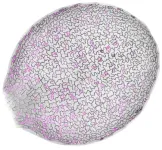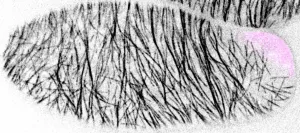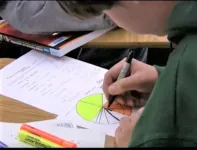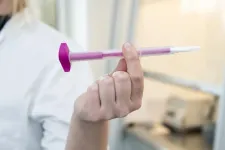(Press-News.org) Every time a stem cell divides, one daughter cell remains a stem cell while the other takes off on its own developmental journey. But both daughter cells require specific and different cellular materials to fulfill their destinies. Animal stem cells use the cytoskeleton – a transient network of structural tubules – to physically pull the correct materials from the parent cell into each daughter cell during the split. Plants also have stem cells that need to distribute different materials to each of their daughters, but earlier studies seem to have ruled out an “animal-style” cytoskeleton to accomplish this task. And what plants used instead remained elusive – until now.
In a new study published July 6 in Science, researchers at Stanford University found that plant cells also use the cytoskeleton. But there’s a twist. Instead of pulling on the cytoskeleton, like animal stem cells, the plant cells they studied actually pushed it away.
“Instead of using the cytoskeleton to say, ‘Divide this way!’ the plants said, ‘DON’T divide this way!’ ” said Andrew Muroyama, a former postdoctoral fellow at Stanford, currently an assistant professor at the University of California, San Diego, and the lead author of the paper.
The new finding could help researchers to engineer plants that are more adaptable to changing environments – a critical task as the world continues to face climate change.
“Understanding how stem cells divide in animals has been important for understanding various human diseases and has impacted translational medicines,” said Muroyama. “I have a similar hope that improving our understanding of how stem cells divide in plants might inform engineering applications in the future.”
Blocking wall construction by threatening catastrophe
Researchers in the lab of Dominique Bergmann, the Shirley R. and Leonard W. Ely, Jr. Professorship in the School of Humanities and Sciences professor of biology, began this work by investigating polarity complexes – little clusters of proteins that are critical in each cell to build leaves of the proper size and shape. Polarity complexes help dividing leaf stem cells orient themselves. “Stem cells use these polarity proteins to decide where to divide,’ ” said Muroyama. “We knew those proteins were involved in division, but we didn’t know how they controlled the process at the molecular level.”
To investigate how these proteins work, the team developed plant cell lines that expressed fluorescent versions of polarity complex and cytoskeletal proteins, then spent hundreds of hours in a dark room, tracking the glowing proteins’ movements while cells grew, divided, and repeated.
They soon observed that some cells weren’t dividing according to the “shortest wall rule,” which normally governs plant cell division. While plant cells are expected to build the smallest – and therefore most energetically conservative – walls possible to divide cells, in some cases, the polarity complex was located right where that wall would need to be built. Somehow, it blocked construction. Through a series of rigorous experiments, the researchers concluded that the polarity complex was pushing away the microtubules that would otherwise enable the construction of the wall.
“The polarity complex was like, ‘If any of you microtubules try to encroach on my region, I’m going to force you away. I’ll literally cause a catastrophe – that’s the technical term for completely disrupting microtubules – so you can’t invade this zone,’ ” said Bergmann.
Management for a changing climate
Bergmann’s lab is interested in resilience – how plants cope with changing environments. Plants survive by changing their leaves or their branch patterns, or the rates at which they respire or store sugars.
“This research could lead to applications where stem cell behavior could be tuned, for example, to alter plant architecture, or to help plants adjust to a changing climate,” said Muroyama.
Decisions about how to respond to signals from the environment are directed by stem cells. Within this process, Bergmann compares the polarity complex to a construction manager, giving the directions that ensure the stem cell splits properly.
“This construction manager receives signals from the environment, decides what to do, and tells the cell, ‘Yes, you should divide.’ But then it also says, ‘Now you’ve divided. Go off and seek your fortune,’ ” said Bergmann.
Now that the researchers know how this manager works, they can determine its role in upstream and downstream processes – and figure out ways to harness its power.
“Exactly how the polarity complex works is something we still need to figure out,” said Bergmann. “How do you get all these plants that make really cool specialized cells – cells that make interesting shapes, cells that make interesting chemicals, cells that respond to certain stimuli? And can we engineer that to happen?”
Yan Gong, PhD ’21, and Kensington Hartman, a staff research associate at the University of California, San Diego are co-authors of this work. Bergmann is also a member of Stanford Bio-X and the Stanford Cancer Institute, and an investigator of the Howard Hughes Medical Institute (HHMI).
This research was funded by the National Institutes of Health, University of California, San Diego, Stanford University, and HHMI.
END
New insight into how plant cells divide
2023-07-06
ELSE PRESS RELEASES FROM THIS DATE:
Eliminating extra chromosomes in cancer cells prevent tumor growth
2023-07-06
New Haven, Conn. — Cancer cells with extra chromosomes depend on those chromosomes for tumor growth, a new Yale study reveals, and eliminating them prevents the cells from forming tumors. The findings, said the researchers, suggest that selectively targeting extra chromosomes may offer a new route for treating cancer.
The study was published July 6 in the journal Science.
Human cells typically have 23 pairs of chromosomes; extra chromosomes are an anomaly known as aneuploidy.
“If you look at normal skin or normal lung tissue, for example, 99.9% of the cells will have the right number of chromosomes,” said ...
Fantasy football in math class?
2023-07-06
While mathematics is a fundamental skill crucial to daily life, U.S. parents today see math education as boring, outdated, and disconnected from the real world. (1) At the national level, short and long-term achievement trends paint a disconcerting picture of the need for innovative math education strategies:
Math scores among eighth graders dropped in 2022, to the lowest score since 20031
Math scores declined for students regardless of racial and ethnic group, gender, parental education, or disability status1
The COVID-19 pandemic exacerbated declines in math achievement; the median school district lost about ...
Mobile phone data used for public health underrepresent vulnerable populations
2023-07-06
UNIVERSITY PARK, Pa. — Mobile phone data are increasingly used in public health management and disease outbreak response, as demonstrated during the COVID-19 pandemic when location data were used as a proxy for human movement and contacts and informed exposure notification apps. However, a new study led by researchers at Penn State revealed that phone data may not accurately reflect under-resourced or particularly vulnerable populations, who are often underrepresented in other data as well.
If this bias is not acknowledged or complemented with additional ...
Researchers discover potential molecular indicators for Parkinson’s symptoms
2023-07-06
Hand tremors and slowed movements are two of the most widely recognized hallmarks of Parkinson’s disease, and for many sufferers the first indication that something is amiss. But by the time these symptoms manifest, those patients have already lost 50–80 percent of their dopamine neurons—a mass die-off that causes the neurodegenerative disease. Malfunctions in dopamine-dependent areas of the brain are responsible for many of the symptoms, which differ from person to person in an unpredictable way.
A diagnosis at an early age, typically before age 50, can stave off the most severe symptoms for years; when the disease is identified later, its trajectory is often swift ...
Study supports “catch up” HPV test in older women
2023-07-06
For women over the age of 65 who have never had a high-risk human papillomavirus (HPV) test, a “catch up” HPV screening intervention may improve cervical cancer prevention by detecting more cervical pre-cancer lesions as compared to women not offered screening. That is the conclusion of a new study publishing July 6th in the open access journal PLOS Medicine by Mette Tranberg, University Research Clinic for Cancer Screening, Randers Regional Hospital, Denmark, and colleagues.
High-risk human papillomavirus (HPV) test is replacing cytology as the primary cervical cancer screening test in most countries, but many women over 65 years have never had an HPV ...
The solstice switch: Warming’s effects on autumn leaf senescence depend on timing
2023-07-06
How temperate and boreal trees’ leaves respond to climate change remains uncertain. Now, a new study of northern forests reports that while early-season climate warming – that occurring before the summer solstice – tends to be associated with earlier autumn leaf senescence, late-season warming (after the summer solstice) has the opposite impact, delaying onset of leaf senescence in fall. “Improved models of plant development and growth under climate change will need to incorporate the reversal of warming effects after the summer solstice,” write Constantin Zohner and colleagues, authors of the study. Climate change ...
Two studies report: Perovskite-silicon tandem cells that break the 30% efficiency threshold
2023-07-06
In two separate studies, researchers present novel methods that enable the fabrication of high-performance perovskite-silicon tandem solar cells with power conversion efficiencies exceeding 30%. Silicon solar cells – the most commonly deployed photovoltaic (PV) technology – are rapidly approaching their theoretical power conversion efficiency (PCE) limit of 29%. One way to increase the efficiency of a solar cell is to optimize the spectrum of sunlight for conversion into energy. This can be done by stacking two or more interconnected photoactive materials into a singular device, improving ...
Precipitation tolerance helped explain which vertebrate species spread between newly joined continents
2023-07-06
A new study helps explain why rates of species exchange are at least twice as high from west to east than in the opposite direction across Wallace’s Line. The study included an analysis of more than 20,000 species belonging to all 227 families of terrestrial vertebrates present in the Indo-Australian archipelago. As tectonic plates merge, once disparate continents can connect and create new opportunities for biotic exchange. Species movement across newly connected continents millions of years ago continues to shape assemblages of flora and fauna today. One of the most well-known ...
Ready for its close-up: The electron’s permanent electric dipole moment
2023-07-06
A new study with direct implications for one of the most important unresolved questions in physics – the imbalance of matter and antimatter in our universe – reports “the most precise measurement yet” of the size of the electron’s permanent electric dipole moment. The imbalance between matter and antimatter in the Universe can be explained via the breaking of charge parity symmetry. The standard model (SM) of particle physics predicts a slight breaking of this symmetry, but it is insufficient to explain the imbalance actually observed. Many extensions to the standard ...
Policymakers should consider animal welfare in decisions
2023-07-06
Incorporating animal welfare into policymaking may improve policy and practice, according to Rutgers research.
The article, published in Science, notes that animal welfare rarely is considered during policymaking, explains why current tools make it difficult to incorporate the well-being of animals into public policy and identifies methods for remedying these issues.
“Animal welfare is often ignored in policymaking, despite its relevance across many domains ranging from food systems to biomedical research to climate policy,” said Mark ...




